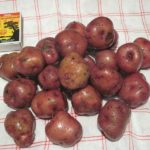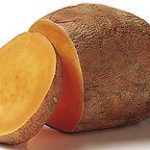By Catherine Haug, April 20, 2017 (Photo, right, from Wikimedia Commons).
Most grocers keep true potatoes in the refrigerated produce section, and sweet potatoes at room temperature, both under bright lights. But this doesn’t mean that’s where you should store them at home.
When stored improperly, “they might look OK; but when cooked, they may emit harmful properties that they wouldn’t have, otherwise. They can become not just slightly shrunken and wrinkly, but potentially toxic.” Why?
How should they be stored?
Types of potatoes, yams
(Photo, right, is from Wikimedia Commons, originally from robbwolf.com (5))
In the details that follow, note the differences between true potatoes, sweet potatoes and true yams:
- True potatoes, both white and purple varieties (have eyes), are all members of the nightshade (Solanaceae) family (Solanales order). White potatoes have tan, yellow or red skins and white flesh; purple potatoes have dark purple skin and flesh. Note that the purple variety has greater antioxidant content, due to anthocyanins that produce the purple pigment
- Sweet potatoes and the more orange variety we call yams (neither have eyes) are both members of the morning glory or Convolvulaceae family (Solanales order, same as true potatoes). They can have skins from tan, orange, red or purple, and their flesh can be anywhere from light yellow to red-orange. Like purple true potatoes, the purple variety has greater antioxidant content, due to anthocyanins that produce the purple pigment
- True yams, also tubers, come from Africa and are members of the Dioscorea family (Dioscoreales order – different from potatoes and sweet potatoes), and are related to palms!
What happens when all types of potatoes, yams are chilled, or cooked at high temperatures?
“When potatoes (both white and purple variety) are chilled, an enzyme known as invertase breaks down the sucrose (aka sugar) they contain and turns it into fructose and glucose, also called dextrose, the main sugar manufactured by your body and your chief source of energy.” (2) Note that cooking them at high temperatures, such as deep frying, also produces acrylamide.
According to the Food Standards Agency: “These two sugars, fructose and glucose, combine with the amino acid asparagine in potatoes and form acrylamide when they’re baked, fried or otherwise heated [above 120°C or 250°F, which is above boiling point of water].” (3) Acrylamide is known to be carcinogenic, and “is also a skin irritant and may be a tumor initiator in the skin, potentially increasing risk for skin cancer.” (6)
To avoid the toxicity of acrylamide from cooked potatoes, you must store them properly – not chilled, but in a cool, dark and dry spot. Do not store in a refrigerator, nor cold or damp root cellar.
High-temperature cooking – especially deep frying (as in potato chips and French fries) – also produces acrylamide. Here are some tips from Mercola (8):
- “Frying, baking and broiling appear to be the worst offenders, while boiling or steaming appear to be much safer
- Longer cooking times increase acrylamide, so the shorter the duration of cooking, the better
- Soaking raw potatoes in water for 15-30 minutes prior to roasting may help reduce acrylamide formation during cooking
- The darker brown the food, the more acrylamide it contains (for instance, dark brown toast compared to light brown toast)
- Acrylamide is found primarily in plant-based foods, such as potatoes and grain products (not typically in meat, dairy or seafood)”
See also Easy Ways to Avoid (Cancer Causing) Acrylamide in Home Cooking for ideas (7).
How should these vegetables be stored?
To avoid potato acrylamide, you must store them properly: “store loosely (not in plastic) in a dark, dry spot at around 50°F to 60°F, but not cold and never refrigerated.” (4). This applies to the all types of potato and yams listed above.
References:
- Mercola: articles.mercola.com/sites/articles/archive/2017/04/08/how-to-store-potatoes.aspx
- MedicineNet Match 19, 2012
- The Food Standards Agency
- Still Tasty 2017
- Rob Wolf.com photo: http://robbwolf.com/2011/04/20/growing-sweet-potatoes/
- en.wikipedia.org/wiki/Acrylamide
- thehealthyhomeeconomist.com/easy-ways-avoid-acrylamide-home-cooking/
- Mercola cooking tips: articles.mercola.com/sites/articles/archive/2012/06/09/when-you-heat-natural-plantbased-foods-you-can-get-acrylamide-and-cancer.aspx
Tags: acrylamide, potatoes, yams

